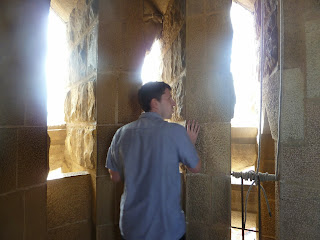Today was the day Nick had been waiting for. We went to see the two famous works of Antino Gaudi: Park Guell and La Sagrada Familia.
We started the morning at Park Guell. We had to hike up a mountain to get there. No, really. It was a mountain-like hill just to get to the park:
Then another dirt path to get to the top of the hill on a cross-monument. The climb up afforded us with some beautiful views overlooking Barcelona and the ocean.
The park itself was a strange mix of Phoenix and New England. There was dirt paths that almost looked deserty (including catci) and pine trees all together. The park was filled with pathways and bridges all designed by Gaudi. He was an architect that was inspired by nature, particularly trees. You could really see that in the bridges. One in particular looked exactly like the spiny trees we saw earlier (see picture post).
After exploring the park itself, we went into the area of buildings built by Gaudi. The park was to be a gated community of sorts for the 1900s, but they ran out of money to build it. The stuff that did get built looked like it came directly form a Dr. Seuss book. But, unlike in amusement parks where those buildings look crazy and are unusable, everything that Guadi did had a purpose. You could really see that in the church, but a little in the park as well.
We even took a selfie on the famous bench, no selfie stick needed!
After the park, we wondered through the neighborhood until we found a place to eat. They eat late in Barcelona so the restaurant we ultimately found was just opening when we got there at 1:15pm. It was fun to watch the difference in people between Rome and Barcelona while once again enjoying a meal on the street.
After lunch it was a short walk to La Sagrada Familia. This Basicilla was unlike any we had seen before. You walk in and are struck immediately by two things: how tall the building is, and how colorful it is. Gaudi designed the inside columns to look like tree trunks, branching as they go up to support the ceiling, designed to look like a canopy of leaves. The hyperbolic structure of the ceiling and choir loft 30m above the ground is designed to carry sound throughout the church since Gaudi believed music was the best way of worship. The stained glass windows of the church cast color everywhere. We came in the afternoon, when the light is brightest and mainly oranges and reds to represent Christ's death and resurrection. On the other side, the colors are blues and greens for Christ's birth. It was absolutely breathtaking. He really took the beauty inherent in God's creation and reflected that in the design of the Church. It was not artists that made the church magnificent, but God himself.
We were also able to take an elevator to the top of one of the towers to get some amazing views of Barcelona. We took the stairs down. They were less scary this time around, with a real handrail and not a rope to hold onto on the way down.
Take a minute to appreciate the outside facades of the church. The first completed was the Nativity of Christ, the second the Passion. They are currently working on the Glory facade. (The three mysteries of the Rosary when Gaudi was alive). I won't go into the details, but each facade was full of symbolism.
After that, we found the "hip" section of Barcelona to enjoy a night of tapas and local draft beer. Then it was time to pack, sleep and head home.
We started off our honeymoon in one of the oldest churches in the world. We ended it in one of the newest. In between, we visited the most important church in the Catholic church. Through our preparation for marriage, we talked a lot about wanted a marriage built with Christ as the center. A family that modeled God's love for us. This honeymoon was an awesome way to cement this commitment and start our marriage off right.

























I had no idea about Gaudi. Gorgeous church! Such a wonderful beginning to your marriage. Safe travels home.
ReplyDelete